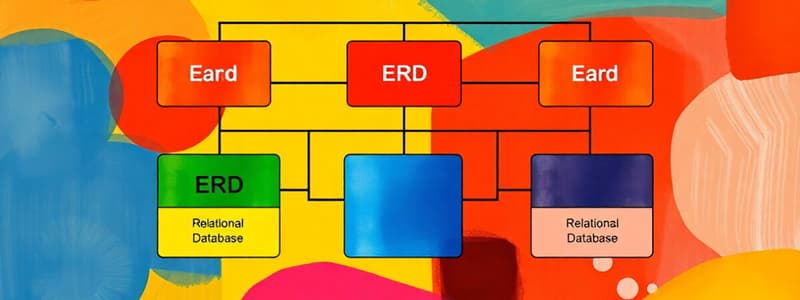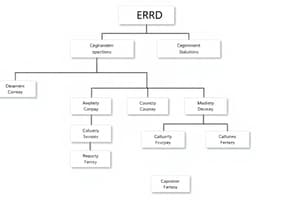Podcast
Questions and Answers
In the context of converting ERDs to tables, what does an entity typically become?
In the context of converting ERDs to tables, what does an entity typically become?
- A relationship between tables
- A column in a database
- A table with attributes as columns (correct)
- A row in a table
Which notation correctly represents a table definition?
Which notation correctly represents a table definition?
- TABLENAME (attribute1, attribute2, attribute3) (correct)
- TABLENAME {attribute1, attribute2, attribute3}
- TABLENAME <attribute1, attribute2, attribute3>
- TABLENAME [attribute1, attribute2, attribute3]
In table definitions, what does the underline signify?
In table definitions, what does the underline signify?
- Indexed attribute
- Foreign key
- Unique attribute
- Primary key (correct)
Which of the following is the best practice when naming tables based on entities?
Which of the following is the best practice when naming tables based on entities?
What is the primary purpose of a foreign key in relational database tables?
What is the primary purpose of a foreign key in relational database tables?
In a one-to-many relationship, where does the foreign key typically reside?
In a one-to-many relationship, where does the foreign key typically reside?
In the context of database design, what is a junction table used for?
In the context of database design, what is a junction table used for?
Which of the following accurately describes a composite primary key?
Which of the following accurately describes a composite primary key?
In the ORDERPRODUCT table, which fields typically function as both primary and foreign keys?
In the ORDERPRODUCT table, which fields typically function as both primary and foreign keys?
Why might a one-to-one relationship be used in database design?
Why might a one-to-one relationship be used in database design?
Which characteristic is unique to foreign keys, compared to primary keys?
Which characteristic is unique to foreign keys, compared to primary keys?
Consider a scenario where an attribute should be both a primary key and reference another table. How is this implemented in a junction table?
Consider a scenario where an attribute should be both a primary key and reference another table. How is this implemented in a junction table?
In a database for a library, books can have multiple authors, and authors can write multiple books. How would you represent this relationship when converting the ERD to tables?
In a database for a library, books can have multiple authors, and authors can write multiple books. How would you represent this relationship when converting the ERD to tables?
When converting an ERD to tables and implementing a one-to-one relationship for 'access control' on sensitive data, what is the primary design consideration?
When converting an ERD to tables and implementing a one-to-one relationship for 'access control' on sensitive data, what is the primary design consideration?
What design considerations should be accounted for when a junction table includes additional columns beyond the foreign keys?
What design considerations should be accounted for when a junction table includes additional columns beyond the foreign keys?
Given two entities, A and B, in a one-to-one relationship where A contains critical identification data, and B contains optional supplementary data. If frequent queries only require A's data, how should this relationship be optimized for performance?
Given two entities, A and B, in a one-to-one relationship where A contains critical identification data, and B contains optional supplementary data. If frequent queries only require A's data, how should this relationship be optimized for performance?
In the context of converting ERDs to relational database schemas, how does the choice between using a junction table versus embedding a multi-valued attribute impact query complexity and data integrity?
In the context of converting ERDs to relational database schemas, how does the choice between using a junction table versus embedding a multi-valued attribute impact query complexity and data integrity?
Consider implementing a 'soft delete' strategy (marking records as deleted instead of physical deletion) in a database converted from an ERD. How does this impact the design of primary and foreign key relationships, especially within junction tables?
Consider implementing a 'soft delete' strategy (marking records as deleted instead of physical deletion) in a database converted from an ERD. How does this impact the design of primary and foreign key relationships, especially within junction tables?
Given a scenario where a database is being designed to track complex supply chain relationships, involving multiple entities with varying cardinalities and optional attributes. Which strategy best balances the need for query performance, data integrity, and flexibility in accommodating future changes?
Given a scenario where a database is being designed to track complex supply chain relationships, involving multiple entities with varying cardinalities and optional attributes. Which strategy best balances the need for query performance, data integrity, and flexibility in accommodating future changes?
You are tasked with designing a database for a social networking platform where users can follow each other. Considering the potential for billions of users and complex relationship queries, which relational database design strategy would be most scalable and efficient for managing the 'follows' relationship?
You are tasked with designing a database for a social networking platform where users can follow each other. Considering the potential for billions of users and complex relationship queries, which relational database design strategy would be most scalable and efficient for managing the 'follows' relationship?
Flashcards
ERD to Tables
ERD to Tables
Entities in an ERD become tables, with the entity's attributes becoming the columns of the table.
Foreign Key
Foreign Key
An attribute in a table that links to another table, establishing a relationship based on shared data.
One-to-Many Foreign Key
One-to-Many Foreign Key
In a one-to-many relationship, the 'many' side table receives a foreign key referencing the 'one' side's primary key.
Junction Table
Junction Table
Signup and view all the flashcards
Composite Primary Key
Composite Primary Key
Signup and view all the flashcards
One-to-One for Access Control
One-to-One for Access Control
Signup and view all the flashcards
Table inheritance
Table inheritance
Signup and view all the flashcards
Study Notes
- The conversion of ERDs to tables is the second stage in the database development process.
Entities to Tables
- Entities from an ERD are converted into tables, with the entity's attributes becoming the columns of the table.
- Table definitions are written using the notation TABLENAME (attribute1, attribute2, attribute3,...), where the underlined attribute represents the primary key.
- Table names are conventionally singular.
- The order of attributes is not important, but the primary key is usually placed first.
- For example, a ‘customer’ entity becomes a CUSTOMER table with attributes CustomerID, FirstName, LastName, Phone, and Address.
Foreign Keys
- Foreign Keys connect tables by establishing a link between them, based on shared data.
- Foreign keys are attributes that depend on the type of relation: one-to-many, many-to-many, and one-to-one.
- Foreign keys do not appear on ERDs.
One-to-Many Relations
- In a one-to-many relation, the "many" side entity receives a foreign key attribute.
- The foreign key in the "many" side table contains the primary key from the "one" side table it relates to.
- For example, the CustomerID is added to the ORDER table as a foreign key (CustomerID) to link customers to their orders.
- Tables are connected with primary keys and foreign keys
Many-to-Many Relations
- In a many-to-many relation, a junction table is created to connect the two entities.
- A junction table contains the primary keys of both tables, acting as both foreign and primary keys.
- A primary key with multiple columns is called a composite primary key.
- For example, in an online shop database, the ORDERPRODUCT table connects ORDER and PRODUCT tables, and contains OrderID and ProductID, and Quantity.
Online Shop Example
- The final tables for an online shop database example are:
- CUSTOMER (CustomerID, FirstName, LastName, Phone, Address)
- ORDER (OrderID, DateTime, CustomerID)
- PRODUCT (ProductID, Description, Price, BrandID)
- BRAND (BrandID, Address, Phone)
- ORDERPRODUCT (OrderID, ProductID, Quantity)
One-to-One Relations
- One-to-one relationships can be used in scenarios where:
- Access control is needed for confidential data, placing that data in a separate table.
- Table inheritance is desired to add more attributes to a table.
- Example of table inheritance
- PERSON (PersonID, FirstName, LastName, DOB, Address)
- STUDENT (PersonID, StudentNo, Degree, ATAR)
- STAFF (PersonID, StaffNo, Office, Salary)
Studying That Suits You
Use AI to generate personalized quizzes and flashcards to suit your learning preferences.



